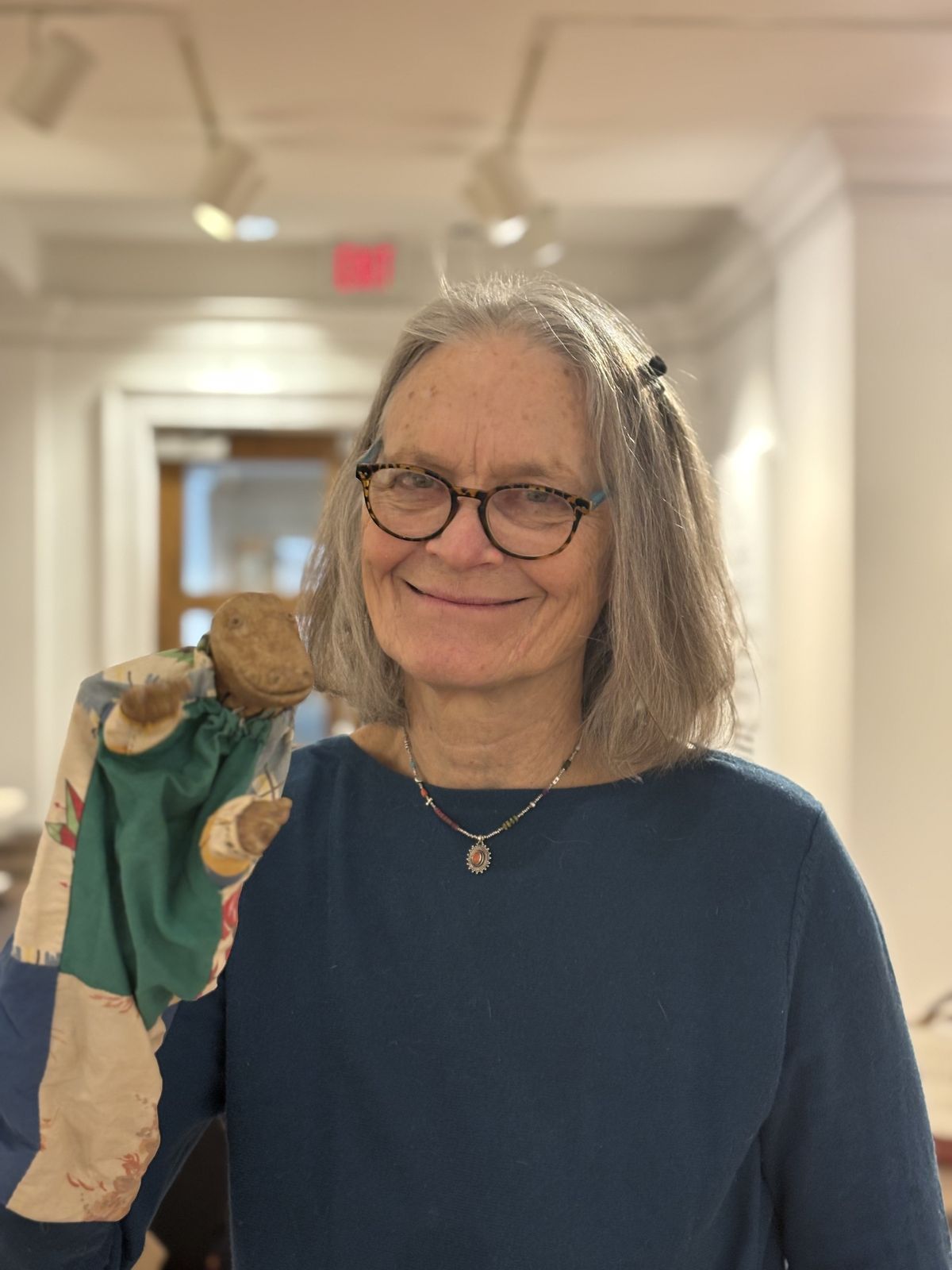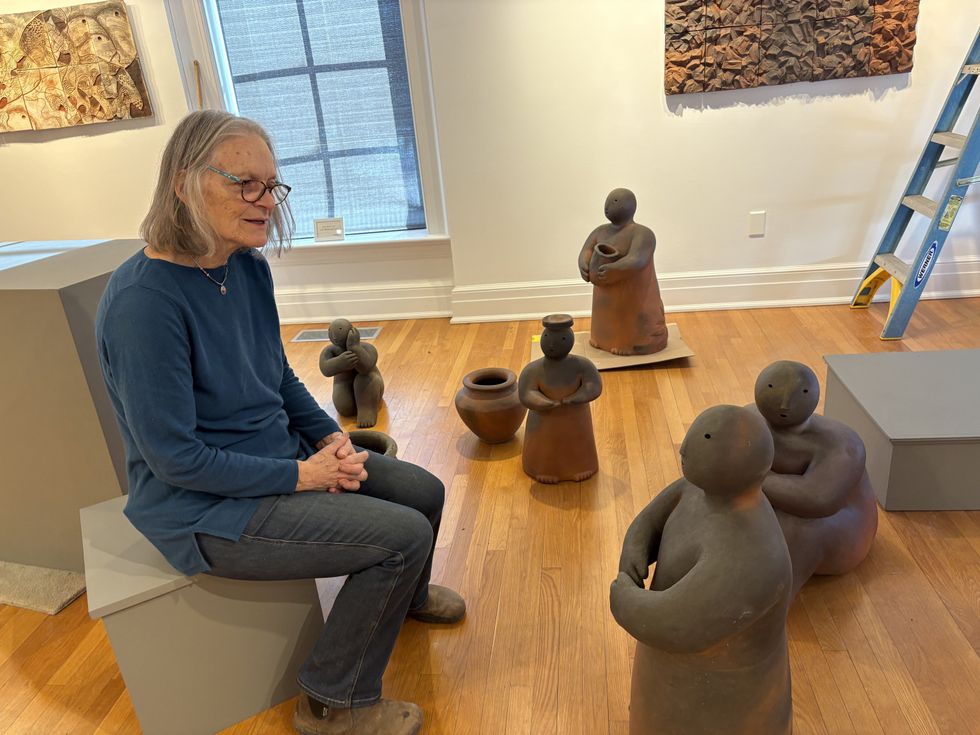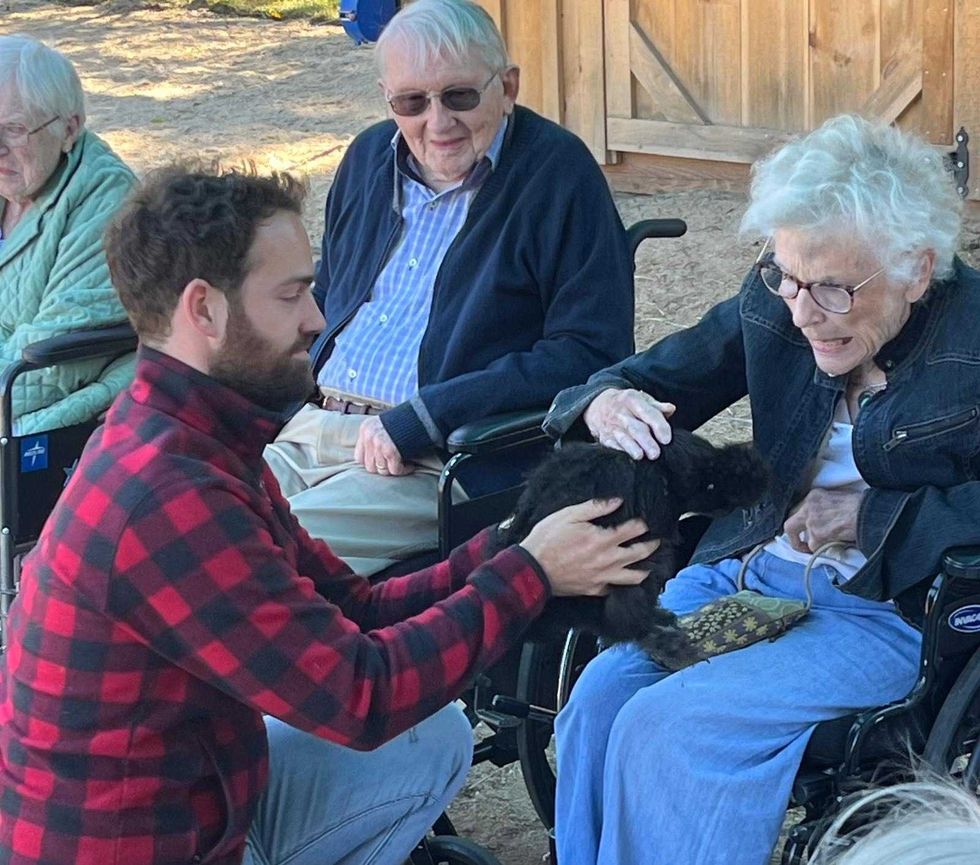Joy Brown’s retrospective celebrates 50 years of women at Hotchkiss

Joy Brown installing work for her show at the Tremaine Art Gallery at Hotchkiss.
Natalia Zukerman

Joy Brown installing work for her show at the Tremaine Art Gallery at Hotchkiss.
This year, The Hotchkiss School is marking 50 years of co-education with a series of special events, including an exhibition by renowned sculptor Joy Brown. “The Art of Joy Brown,” opening Saturday, Feb. 22, in the Tremaine Art Gallery, offers a rare retrospective of Brown’s work, spanning five decades from her early pottery to her large-scale bronze sculptures.
“It’s an honor to show my work in celebration of fifty years of women at Hotchkiss,” Brown shared. “This exhibition traces my journey—from my roots in pottery to the figures and murals that have evolved over time.”
Co-curated by Christine Owen, Hotchkiss ceramics instructor, and Joan Baldwin, curator of special collections, the scale and scope of the exhibition was inspired by a recent Ed Ruscha retrospective in Los Angeles. “I thought it would be incredible to showcase all these different aspects of Joy’s work,” said Owen, who has known Brown for over 30 years.
Brown’s father, a Presbyterian missionary and medical doctor, opened a hospital in Japan where Brown grew up and cultivated her love of clay. Her first apprenticeship was in Tomba, a region in Hyogo Prefecture known for its ancient pottery kilns and Tambayaki pottery. “There are thousands of years of continuous history of clay there and I was working with a 13th generation potter.” Brown recalled that as part of her early training, her teacher handed her a sake cup and said, “make these.” With no extra instruction given, Brown proceeded to make thousands of copies of the cup. Never fired, she realized that the pieces were an exercise. She explained, “You’re not really making something, you’re participating in a process that these things emerge from.” From there, she embarked on an apprenticeship with master potter Shigeyoshi Morioka. As part of the process she learned from Morioka, Brown has built a 30-foot-long wood-firing tunnel kiln on her property in Kent, Connecticut, where she fires her work once a year in an intensive month-long process. The fire’s natural interaction with the clay creates unique earth tones and ash patterns, highlighting the raw beauty of the material.

“I learned not just pottery but a whole way of life,” she recalled. “The work is a continuous process—like practicing a signature until it evolves into something uniquely yours.” Her figures, initially emerging as playful puppets, have since evolved into large-scale sculptures now found in public spaces from Shanghai to Broadway to Hotchkiss’s own campus.
Brown’s seven-foot “Sitter with Head in Hands” was installed near Ford Food Court in October, followed by “Recliner with Head in Hands” near Hotchkiss’s Main Building in November. She welcomes interaction with her sculptures, encouraging visitors to touch them and even dress them with scarves or hats. “These figures transcend gender, age, and culture,” Brown noted. “They’re kind of like when you’re 4 years old and you didn’t know or care what you were, you know? All of us meet in that field and I think people resonate with that.”
In conjunction with the exhibition, Hotchkiss will host a screening of “The Art of Joy Brown,” a documentary by Eduardo Montes-Bradley, followed by a panel discussion with the artist and filmmaker on March 6 in Walker Auditorium. Brown will also serve as an artist-in-residence, collaborating with students on special projects.
On being part of the celebration of women at Hotchkiss Brown said, “Fifty years ago, I was deep in the mountains of Japan, immersed in clay.” With a soft spoken and almost childlike quality, Brown spoke about and interacted with her pieces with curiosity, reverence and wonder.
“The practice of working with clay for all these years is grounding and centering for me. It challenges me,” she said. “The work forces me to put myself out there. It’s not just the making of the pieces that make me more whole, the pieces themselves become more present.”
Brown reflected on the retrospective nature of the show and shared that putting it together has been like looking at a family album. “It’s kind of like I’m seeing my whole life in front of me,” she said. “It’s humbling and makes me think about why I do what I do. It comes back to the idea of those thousands of sake cups, you know? We’re just here, being as present as we can be. We’re not making things, we’re participating in a process of being more present, and all that spirit is reflected in the work.”
“The Art of Joy Brown” opens Saturday, Feb. 22, and runs through April 6. For more information, visit www.hotchkiss.org.
This story has been updated to reflect a change in the scheduled opening date due to forecast extreme weather conditions.
Millerton Police will be enforcing the ban on overnight street parking over the winter beginning Dec. 10. The ban is intended to keep streets clear for plowing.
MILLERTON – The Village of Millerton issued an alert last week reminding residents of its seasonal overnight parking ban.
“In accordance with the provisions of article 151-13 of the Village of Millerton Code, all-night parking is prohibited on all streets within the Village between the hours of 11:30 p.m. and 6:00 a.m. beginning Dec. 10, 2025 and ending April 10, 2026, except for Century Boulevard. Violators will be towed at the owner’s expense.”
The notice was sent through the village’s new TextMyGov alert system. The two-way texting platform allows the village to send emergency or timely updates and gives residents a quick way to report issues, such as water leaks, potholes, stray animals or code violations. Officials encourage residents to save the village’s text number – 518-672-6100 – and use keywords to stay informed.
Millerton Police Chief Joe Olenik, who is also the Interim Superintendent of Public Works, said the longstanding ordinance is tied directly to winter operations.
“Each year from December to April, you can’t park on the street–to allow for snow removal from our plows,” he said. “If people do park on the street, they will be ticketed and eventually towed.”
To get the word out, Olenik said officers on night patrol have been leaving reminder notices on vehicles in both English and Spanish.
“We want to give people advance notice,” he said, noting that officers will continue distributing reminders in the weeks leading up to the December start date.
Beyond protecting vehicles from damage during plowing, Olenik emphasized the public-safety side of the rule. “I want the road completely opened so we have no problem getting the plows through,” he said.
Although the parking ban has been part of the village code for years, it has not been actively enforced. This winter will mark the first season of stricter enforcement.
Willa the Pig lies on a bed of blankets and pillows in her home in Millerton.
MILLERTON — Alanna Broesler didn’t always know she wanted a pet pig. But between watching the movie Babe on repeat as a child and working on a pig farm, the co-owner of Millerton’s farm-to-table restaurant Willa, joked, “there were signs.”
Willa is the restaurant’s namesake — a 130-pound house pig who loves smoothies, snuggling and sassing her family. She is a potbellied and Juliana cross with big spots and a big personality to match.
“Willa has always been a very dominant, kind of cheeky pig,” Broesler said with a laugh. “She’s very vocal.” Willa walks around her Millerton house with confidence and lots of opinions, especially when smoothies are involved. The first rumble of ice, or even the mention of the word “smoothie,” will cause Willa to jolt up from her cozy bed of pillows to investigate the scene. Her favorite blend is oat milk, yogurt and banana.
Broesler brought the pig home in 2017 and named her after legendary country singer Willie Nelson. Broesler said she was young at the time, unsure where she would be living, and uneducated about keeping pigs in a house. But after meeting Willa she knew that she wanted to give her a home.
“Looking back, it was irresponsible,” said Broesler — not necessarily because of the circumstances, but because she acquired Willa through a breeder. As she immersed herself in the pig community, Broesler learned about the demand for pig adoption. “Potbellied pigs are constantly getting rehomed and they need stable placements,” she said.
Enter Milo – Willa’s new baby brother. Milo is all black with a bottle-brush tail. His nose is flatter than Willa’s, and he has tusks. Broeslder adopted Milo and rescued him from a “horrible situation,” she said. He was kept in a crate and lacked proper care and affection.
Today, Milo’s favorite activity is grazing in the fenced-in section of Broesler’s yard. Quieter than his older sister — who runs the show, which also includes three cats and two chinchillas —Milo is getting used to home life with free space and loving caretakers.
Broesler didn’t come from a farming background. Her family owns a traditional Irish pub in New York State where she developed a strong work ethic and firsthand knowledge of the service industry. “I’ve been scrubbing potatoes and sweeping sidewalks for as long as I can remember,” Broesler said with a laugh.
But when it came time to apply for college, Broesler knew exactly what her future looked like.
“I always knew I wanted to work outside and with animals,” Broesler said. She sought out as much experience as she could. She milked goats, worked on cattle farms, and grew vegetables and flowers. What stands out vividly is working with pigs. Ultimately, all of her experience led to a farm-to-table restaurant.
But as the restaurant becomes more established a new dream is beginning to take shape. Broesler has just completed paperwork to establish her own pig sanctuary — Willa’s Way — a 501(c)(3) nonprofit.
Though in the preliminary stages, Broesler excitedly describes an elaborate vision. As a destination spot, the sanctuary would add value to the community in myriad ways, incorporating farm-fresh eggs, native flowers, in-season vegetables and educational opportunities related to sustainability.
At its core, the pig sanctuary would be in service of the animals. It would support rehabilitation, rehoming or placement, public education, and simply letting older pigs live out their remaining days with love and care.
“The most common question I get is, ‘Where would we be rescuing the pigs from,’” said Broesler. “People don’t often realize how huge the need is because of bad breeders, hoarding cases, or bad characters who lie about micropigs or teacup pigs, claiming they’ll remain 25 pounds.”
She adds that adopting Milo lit the fire for the sanctuary idea. “To watch him come to me as a sick, malnourished, really sad pig and come out of his shell with a funny personality – and he’s getting healthy and feeling good – it’s just been the best thing.”
The next steps for the sanctuary are to identify investors, apply for grants, and acquire 30 to 50 acres of land. No small feat, but Broesler is up for the challenge.
Halloween marked the two-year anniversary since Willa opened its doors on Main Street. With a menu that is, of course, pork free, Executive Chef Daniel Meissner has created imaginative farm-to-table offerings that change with the seasons.
“He has such a passion for cooking locally and supporting farmers,” said Broesler. “And he shows people that you can eat seasonally and it can taste amazing.”
The restaurant now works with approximately 20 local farms and vendors, including Thistle Pass, Kinderhook Farm, Harlem Valley Homestead and Off the Shelf Farm, to name a few. Menu items often include nods to farmers by name – a subtle way to spark conversations and celebrate the region’s producers, Broesler said.
When customers come into the restaurant, they often mistake Broesler for “Willa.” She corrects them with a laugh. “No, Willa is a very spoiled potbellied housepig.”
Anthony Musso discusses his book “Hidden Treasures of the Hudson Valley” at the North East Historical Society’s annual meeting on Saturday, Nov. 15. The book centers on historical sites across the region with rich backgrounds and low ticket-prices for maximum accessbility.
MILLERTON — With his signature Brooklyn accent, sense of humor and wealth of knowledge, author and historian Anthony “Tony” Musso brought American Revolution history to life at the NorthEast-Millerton Library Annex in partnership with the North East Historical Society.
The talk marked Musso’s first speaking engagement at the Annex and coincided with the historical society’s annual meeting.
Musso guided attendees through an oral tour shaped by excerpts from his three-volume series, “Hidden Treasures of the Hudson Valley,” which together highlight 165 local historical sites that are rich in history and light on the wallet. Each book features 55 locations that are open to the public.
“I included places that fly under the tourists’ radar,” said Musso, addressing the crowd of more than 30 attendees. “Many of them are run by historical societies, so the added benefit is a free or nominal charge.”
His presentation began with Pawling’s Quaker Hill, where in 1740 a group of Quakers petitioned the Religious Society of Friends to build their own meeting house so they wouldn’t have to travel elsewhere to go to Sunday worship.
“It was kind of small,” Musso remarked of the original structure. “They ran into a problem within the first five years because they had so many people standing around, they couldn’t all get inside.” As a result, in 1767 the Quakers got permission to build a bigger meeting house just across the street.
“This one was a two-story structure with a wrap-around balcony where they could fit everybody inside.” Musso described an event in 1778 during a regular Sunday worship when three officers from the Continental Army came into the meeting house, sat respectfully in the back, and when the service came to a close they announced that they were going to commandeer the building.
“Nearby, George Washington led a large encampment of troops and they wanted to have this building be used as a medical hospital,” Musso said.
During the army’s occupation, the makeshift hospital was overseen by Dr. James Fallon, and many people referred to it as “Fallon’s Hospital.” Approximately 100 troops were treated there throughout its four months of winter operation.
“If you know anything about Quaker beliefs, pacifism is right at the top,” said Musso. “And although the military was not putting armament, cannons or munition in the building — it was for a humanitarian purpose — the Quakers abandoned the building as long as the army was there and found another building down the hillside.”
The Quakers also refused to provide the army with provisions, Musso said, which exacerbated harsh conditions that winter.
When the army left, the Quakers returned to the building and continued with their meetings and worship. Musso added that in 1932, the meeting house was acquired by the historical society of Quaker Hill and Pawling, and “that’s why the building is in such meticulous shape today.”
Musso went on to explain that while George Washington never stayed at encampment with his troops, he did commandeer a house for four months down the hill in the village of Pawling — the home of John Kane, who was originally a Patriot at the start of the American Revolution but switched sides and became a Loyalist.
From there, Musso expanded the tour to Westchester and Rockland counties, including the location where Benedict Arnold turned over the plans, layout and staffing for Fort Arnold to British spy John André — and the site where Andre was subsequently hanged.
As a seasoned historian, speaker and guide, Musso shared one of his tricks if he ever feels like his audience is losing interest. He brings up Hamilton the musical. “I don’t lie to people,” he jokes, “but I say, ‘I can’t prove this, but I’ve heard that some of the music from Hamilton was written here.’”
Though Musso didn’t delve into the rich history of North East’s Coleman Station during the presentation, Musso said it is one of the sites included in his books.
Musso has lived in LaGrange for 40 years, and his career has spanned decades at the post office, writing for the Poughkeepsie Journal, and authoring numerous nonfiction books. “I love the history of this area, and I’m not going to stop telling it anytime soon.”
North East Historical Society annual meeting
Other business from the North East Historical Society included acknowledgements of board members and volunteers. President Ed Downey expressed gratitude for the society’s partnership with the NorthEast-Millerton Library, noted that four members are up for re-election and shared that membership has increased by 54% over the last decade, now totaling 179 — among the highest of any historical society in Dutchess County.
Downey also highlighted ongoing digitization efforts, saying the goal is to “digitize and publish” the historic Millerton Telegram and 90 years of The Millerton News. Downey added that this is a costly project and relies heavily on donations to sustain the work.
Le Petit Ranch offers animal-assisted therapy and learning programs for children and seniors in Sheffield.
Le Petit Ranch, a nonprofit offering animal-assisted therapy and learning programs, opened in April at 147 Bears Den Road in Sheffield. Founded by Marjorie Borreda, the center provides programs for children, families and seniors using miniature horses, rescued greyhounds, guinea pigs and chickens.
Borreda, who moved to Sheffield with her husband, Mitch Moulton, and their two children to be closer to his family, has transformed her longtime love of animals into her career. She completed certifications in animal-assisted therapy and coaching in 2023, along with coursework in psychiatry, psychology, literacy and veterinary skills.
Le Petit Ranch operates out of two small structures next to the family’s home: a one-room schoolhouse for animal-assisted learning sessions and a compact stable for the three miniature horses, Mini Mac, Rocket and Miso. Other partner animals include two rescued Spanish greyhounds, Yayi and Ronya; four guinea pigs and a flock of chickens.
Borreda offers programs at the Scoville Library in Salisbury, at Salisbury Central School and surrounding towns to support those who benefit from non-traditional learning environments.
“Animal-assisted education partners with animals to support learning in math, reading, writing, language and physical education,” she said. One activity, equimotricité, has children lead miniature horses through obstacle courses to build autonomy, confidence and motor skills.

She also brings her greyhounds into schools for a “min vet clinic,” a workshop that turns lessons on dog biology and measuring skills into hands-on, movement-based learning. A separate dog-bite prevention workshop teaches children how to read canine body language and respond calmly.
Parents and teachers report strong results. More than 90% of parents observed greater empathy, reduced anxiety, increased self-confidence and improved communication and cooperation in their children, and every parent said animal-assisted education made school more enjoyable — with many calling it “the highlight of their week.”

Le Petit Ranch also serves seniors, including nursing home residents experiencing depression, social withdrawal or reduced physical activity. Weekly small-group sessions with animals can stimulate cognitive function and improve motor skills, balance and mobility.
Families can visit Le Petit Ranch for animal- assisted afterschool sessions, Frech immersion or family walks. She also offers programs for schools, libraries, community centers, churches, senior centers and nursing homes.
For more information, email info@lepetitranch.com, visit lepetitranch.com, follow @le.petit.ranch on Instagram or call 413-200-8081.